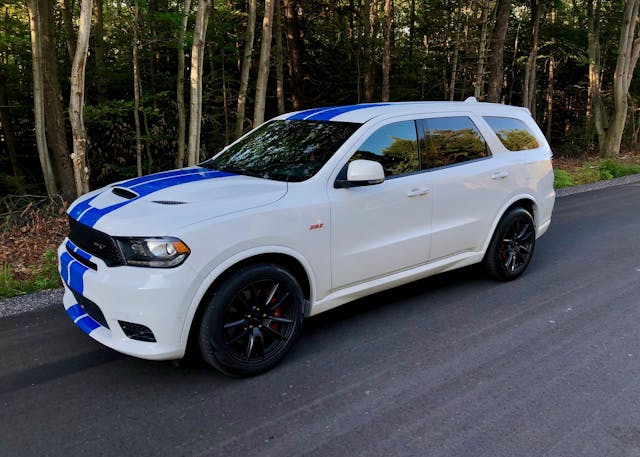Review: 2020 Dodge Durango SRT AWD
The domestic three-row SUV segment is clearly delineated along brand lines. Cadillac and Lincoln have carved out a spot for luxury buyers. Chevrolet, Dodge, Ford, and GMC are happy to serve the rest of the market, from dowdy to dapper, but only Dodge builds a no-compromise, six-seater performance SUV.
2020 marks the ninth year of this Durango’s production cycle, and the fifth since the last refresh. Even the Hemi-powered SRT model in question is three years old, witnessing that the biggest of the Dodge SUVs is showing its age. Dodge will roll out a Hellcat-powered Durango next year, but the only updates the Durango SRT sees for the 2020 model year are cosmetic—a black-accented exterior package and a double-stripe treatment available in 10 colors.
From the moment I first drove the Durango SRT, I was smitten. Rugged American looks, a chassis that’s buttoned down to carve corners, and a 392-cubic inch V-8 that plays the NASCAR soundtrack on repeat make this a distinctive sport utility.
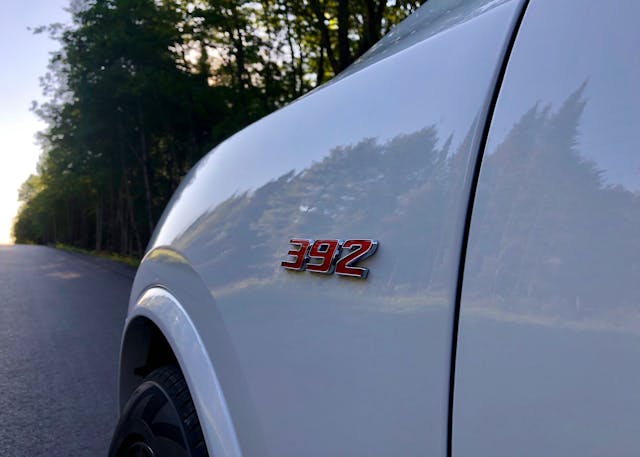
The drivetrain and chassis set the Durango SRT apart from the three-row crowd. The recipe, with which Dodge is now quite familiar, includes a 6.4-liter Hemi V-8, an eight-speed automatic, and a full-time all-wheel-drive system, with eight drive modes suited to a performance-badged sport utility and ranging from Snow and Tow to Sport and Track.
The base Durango SRT is reasonably well equipped at $64,490, but our $77K test car proved that, once you’ve committed to that base price point, some add-ons are must-haves (both prices include destination). The $2395 Technology Group adds adaptive cruise control, among other ADAS features, and the $1195 Group IV towing package is essential to exploit this truck’s 8700-pound towing capacity. You’ll also want to spend $1295 for the big Brembo brake option, with its large calipers and two-piece front rotors. $1195 for dual racing stripes? You could skip those.
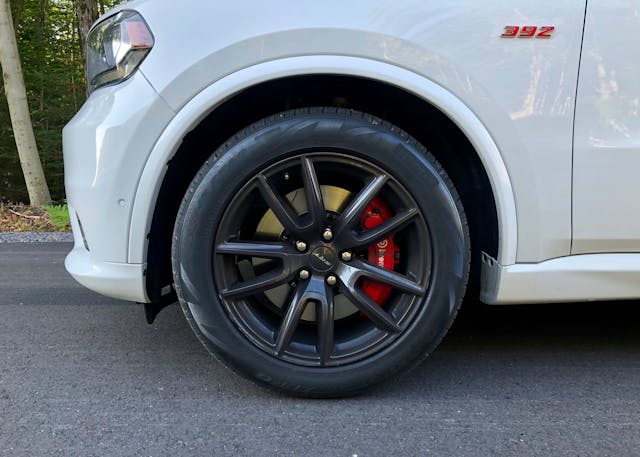
The interior, while underwhelming, benefits greatly from the $2495 Premium Interior Group; the suede headliner and leather dash lend a premium vibe to the cabin that makes the near-six-figure price more palatable. I don’t generally encourage dash stroking, but the optional leather dash and suede headliner are essential to transforming the cabin experience from rental car to downright opulent.
In addition to the 8.4-inch dash-mounted screen, our tester was fitted with second-row screens, a $1995 option. Given that children are armed with phones and tablets today, I suspect that most parents will fail to see the value in this package. The major options our tester did not carry were the $1595 high-performance Laguna leather seats, the $1295 power sunroof, and the $1495 Black Package.

The Durango rides on the long-wheelbase version of the platform shared with the Grand Cherokee and dates back to the Daimler Chrysler era. Dodge hasn’t quite turned a sow’s ear into a silk purse with this SRT SUV, but the Bilstein-supplied adaptive dampers, chassis tuning, and modern Pirelli rubber more than mask the age of the platform.
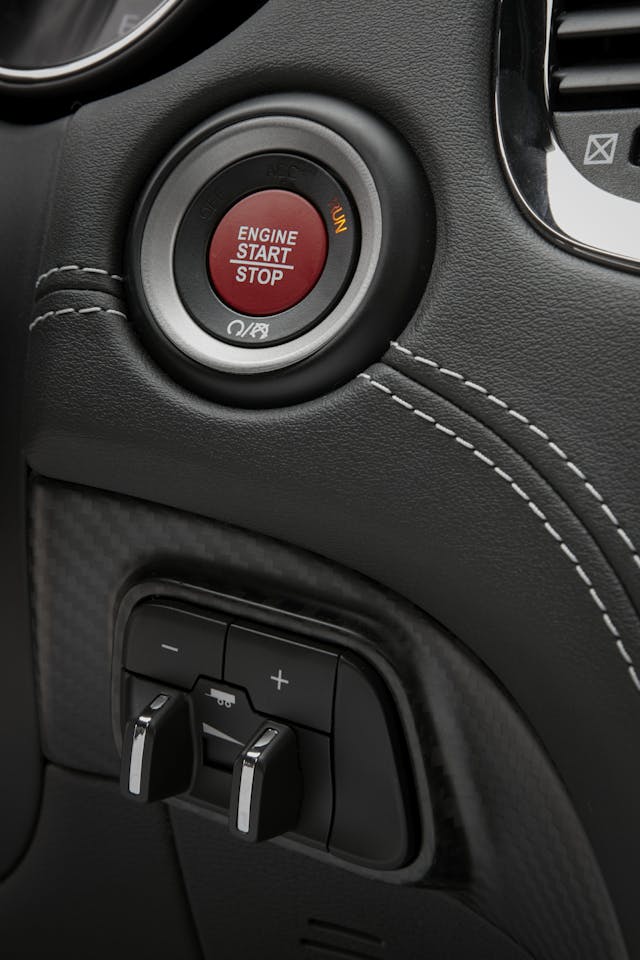
Drivers like me who are less than six feet in stature will find themselves climbing up into the driver’s seat ever so slightly, even when the chair is set to its lowest position. If there ever were an argument for aftermarket lowering springs, the Durango SRT would be the poster child. Once you’re behind the wheel, legroom, headroom, and adjustability of the seat and steering column are generous enough to suit everyone from jockeys to basketball stars.
The Durango’s third row can be deleted with the appropriately named Lightweight Performance Package, but be aware that this option does more than simply remove the rearmost seats. This option replaces both second-row chairs (and their useful console) with a three-butt bench seat. While Dodge doesn’t specify weight savings, I’d estimate that the third-row diet nets a 90-pound loss. The greater benefit, when considering a 5500-pound SUV, is the increased flat real estate, which is useful for carrying bicycles and snowboards. However, if you have children and want to keep them comfortable for more than a 15-minute grocery run, you’ll want to stick with the standard seat configuration.

The 6.4-liter Hemi V-8 makes 475 hp at 6000 rpm and 495 lb-ft at 4300 rpm. It’s backed by the eight-speed 8HP70 automatic and sends power to all four wheels. There is a range of torque split settings depending on the drive mode, varying from an even 50/50 split front/rear to 30/70 when switched to Track. Drive modes also change throttle and transmission maps, as well as damper calibration.

On the road, the low-frequency rumble of that Hemi is always present, reminding you that there’s a significant power reserve at the ready. Leaving a stoplight, cruising on the freeway, there’s that thrum of the 6.4, but when you open the SRT’s throttle and run it through the revs, its howl is reminiscent of NASCAR. There’s no doubt that this truck’s soundtrack is a major attraction for buyers who want to stand out among the three-row SUV crowd. Your Durango SRT will haul your kids and run to Home Depot all day long, but it won’t turn heads; the SRT’s delicious stoplight burble will draw some glances.
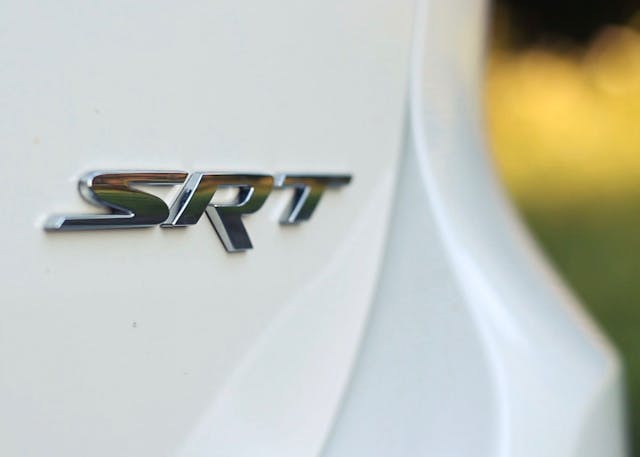
One of the problems, however, is that the Durango SRT can cruise with very little drama at very illegal speeds on the highway. Zero to sixty can be done reliably and repetitively in four and a half seconds, and it can do the quarter in under thirteen. Launch control comes standard, and it works flawlessly.
While the various drive modes are entertaining, I used the custom mode which I set to light steering, soft damping, paddle shifters on, stability system backed off one step, and all-wheel drive set to Track. On wide-open, winding country roads—for example, Ontario’s cottage country—it’s the perfect configuration to let this muscle SUV roar.
It’s surprising how much fun the Durango SRT is to drive, despite the large form factor and 5500-pound curb weight. The transmission shifts according to the drive mode—smoothly in regular modes, and rapidly, both up and down the ‘box, in Sport and in Track. Across the board, feel and feedback are muted, but there’s enough precision in the steering and power in the Brembos to make pushing the Dodge’s limits enjoyable. In day-to-day driving, the ride is firmer than that of a milquetoast crossover, and the drivetrain loses a shade of responsiveness—but remains as potent as ever.

Interior ergonomics are pure Dodge: simple and functional. Compared to some newer sport utilities—especially those across the pond—the interior appears dated, but Dodge hasn’t let utility fall by the wayside. The Uconnect infotainment system and its 8.4-inch display may not be cutting-edge, but they’re easy to use, thanks to a straight-forward, logical interface.
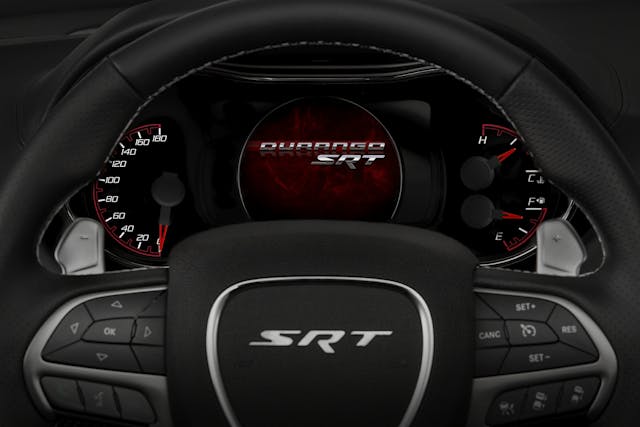
If you favor simplicity over sophistication, you’ll appreciate the buttons and dials across the dash; if you’re coming to a Durango SRT from BMW or Mercedes-Benz, the hard plastics may grate on your nerves. Conspicuously absent is a heads-up display, a feature found on vehicles with a fraction of this SUV’s price. Still, the optional $995 19-speaker harman/kardon sound system is well-balanced, even for my racecar-damaged eardrums, and worth the upgrade.
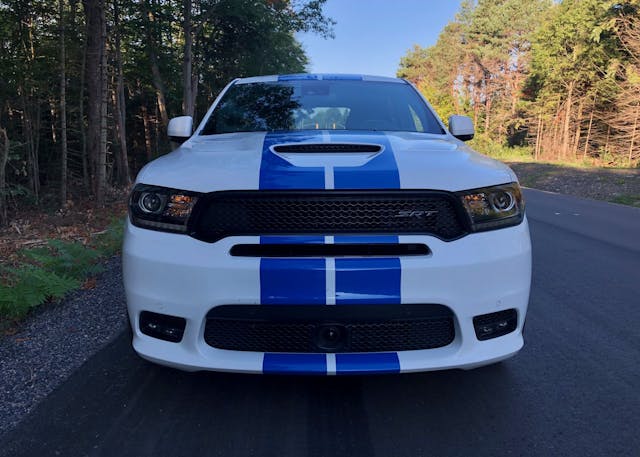
The market for performance-oriented, three-row sport utilities is arguably small. In a battle of performance stats, the 2021 Mercedes-AMG GLS 63 is the Durango’s nearest competition. However, the Benz starts at $133K with destination; there’s little chance buyers will cross-shop it with the $60K–$80K offering from Detroit. The Durango SRT will face stiffer competition from the five-seater Jeep Grand Cherokee SRT and, outside the SUV genre, from the $70K+ Charger Hellcat Widebody.
In a world of dull, homogenized SUVs, the Durango SRT is refreshingly full of in-your-face American attitude.
Highs: The quickest three-row American SUV you can buy.
Lows: Its dated tech and unrefined interior is outclassed by the Hyundai Palisade, which costs $30K less.
Summary: The SUV for families with red-white-and-blue brand loyalty, more than 1.6 children, and the need for speed.
